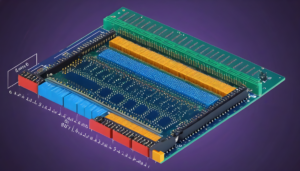Introduction
Welcome to “Mastering SystemVerilog Arrays: A Comprehensive Guide.” In the realm of hardware design and verification, SystemVerilog stands out as a powerful language, and understanding its array of capabilities is crucial for harnessing its full potential. Arrays in SystemVerilog offer a versatile and efficient way to manage data, making them a fundamental aspect of hardware description and verification languages.
A. Brief Overview of SystemVerilog
SystemVerilog, an extension of Verilog, was developed to address the challenges of modern hardware design and verification. It encompasses features that facilitate concise and readable code, making it a preferred language in the semiconductor industry. The language not only supports traditional hardware description but also incorporates powerful constructs for verification, making it an ideal choice for verification engineers.
B. Importance of Arrays in SystemVerilog
Arrays serve as a cornerstone in SystemVerilog programming, offering a structured and efficient means of handling data. Whether dealing with large datasets, complex algorithms, or dynamic data structures, arrays provide the flexibility needed to navigate the intricacies of hardware design and verification. This guide aims to unravel the intricacies of SystemVerilog arrays, from their basic definitions to advanced usage scenarios.
Now, let’s delve into the fundamental concepts of SystemVerilog arrays, exploring their declaration, initialization, and basic operations.
SystemVerilog Array Basics
A. Definition and Declaration of Arrays
In SystemVerilog, arrays are variables that can store multiple values of the same data type. Before delving into their usage, it’s essential to understand how to declare them. The syntax for declaring an array involves specifying the data type, array name, and size.
1. Syntax for Array Declaration
| // Syntax: data_type array_name[size]; bit [7:0] byte_array[255]; // Example declaration of a byte array with 256 elements |
2. Data Types Supported for Arrays
SystemVerilog supports a variety of data types for arrays, including built-in types like bit, logic, and user-defined types. This flexibility allows for the creation of arrays tailored to specific design requirements.
B. Initialization of Arrays
Once declared, arrays can be initialized either explicitly or implicitly. Explicit initialization involves specifying values during declaration, while implicit initialization relies on default values.
1. Explicit Initialization
| bit [3:0] nibble_array[4] = ‘{4’b0000, 4’b0011, 4’b1100, 4’b1111}; |
2. Implicit Initialization
Implicit initialization initializes all elements to their default values based on the data type.
| logic [7:0] data_array[10]; // All elements initialized to ‘0’ |
Understanding these basic concepts sets the foundation for further exploration into array indexing, slicing, and the dynamic aspects of arrays in SystemVerilog, which we’ll delve into in the next section.
Array Indexing and Slicing
A. Understanding Array Indexing
Array elements in SystemVerilog are accessed using indices, and it’s crucial to grasp the indexing conventions. SystemVerilog uses zero-based indexing, meaning the first element of an array has an index of 0. For multi-dimensional arrays, indices are specified for each dimension.
1. Zero-Based Indexing
| logic [3:0] data_array[7]; // Array with indices 0 to 7 data_array[0] = 4’b1010; // Accessing the first element |
2. Multi-Dimensional Arrays
| bit [1:0] matrix[3][2]; // 3×2 matrix matrix[2][1] = 2’b10; // Accessing an element in a multi-dimensional array |
B. Slicing Techniques
Array slicing allows the extraction of a subset of elements from an array. This can be particularly useful when working with large datasets or when specific portions of an array need to be manipulated.
1. Basic Slicing
| logic [7:0] data_array[15]; logic [3:0] subset_array[4]; subset_array = data_array[7:4]; // Extracting elements 7 to 4 from data_array |
2. Advanced Slicing for Multidimensional Arrays
| bit [7:0] matrix[3][3]; bit [3:0] column_subset[3]; column_subset = matrix[1:3][2]; // Extracting the entire second column from the matrix |
Understanding array indexing and slicing lays the groundwork for exploring dynamic arrays and associative arrays, which offer even greater flexibility in handling data in SystemVerilog. In the following sections, we’ll delve into these advanced array types and their applications.
Dynamic Arrays in SystemVerilog
A. Introduction to Dynamic Arrays
Dynamic arrays in SystemVerilog provide a flexible alternative to fixed-size arrays. Unlike static arrays, dynamic arrays don’t require a predefined size during declaration, allowing for dynamic allocation and resizing during runtime.
B. Dynamic Array Methods and Functions
1. Using the “new” Keyword
The new keyword is employed to dynamically allocate memory for a dynamic array. This enables the creation of arrays without specifying a fixed size at compile time.
| logic [] dynamic_array; // Dynamically allocating memory for the dynamic array dynamic_array = new[10]; |
2. Resizing Arrays
Dynamic arrays can be resized during runtime using the $resize system task. This task allows the array to grow or shrink as needed.
| // Resizing the dynamic array to accommodate 20 elements $resize(dynamic_array, 20); |
Understanding the dynamics of dynamic arrays opens the door to more adaptive data structures in SystemVerilog. However, when it comes to associative arrays, SystemVerilog offers a unique and powerful tool for handling complex data relationships.
Associative Arrays in SystemVerilog
A. Definition and Purpose of Associative Arrays
Associative arrays, also known as “hash” or “unordered” arrays, differ from traditional arrays in that they use keys instead of indices to access elements. This makes them particularly useful for scenarios where the relationship between data points is not strictly sequential.
B. Operations on Associative Arrays
1. Adding and Removing Elements
| // Declaration of an associative array int associative_array[string]; // Adding elements to the associative array associative_array[“apple”] = 5; associative_array[“banana”] = 8; // Removing an element associative_array.delete(“apple”); |
2. Iterating Through Associative Arrays
| foreach (associative_array[key]) begin // Accessing each element in the associative array $display(“Key: %s, Value: %0d”, key, associative_array[key]); end |
As we explore associative arrays, we’ll uncover their usefulness in various applications, from handling configuration data to efficiently managing complex data relationships in verification environments.
In the upcoming sections, we’ll delve into practical array manipulation techniques, including sorting and searching arrays, and showcase real-world examples of SystemVerilog array usage. Understanding these advanced topics will empower you to leverage arrays effectively in your hardware design and verification projects.
SystemVerilog Array Manipulation
A. Sorting Arrays
1. Using Built-in Sorting Functions
SystemVerilog provides convenient built-in functions for sorting arrays. The $sort function simplifies the process of arranging elements in ascending or descending order.
| logic [7:0] data_array[10]; $sort(data_array); // Sorting data_array in ascending order |
2. Implementing Custom Sorting Algorithms
For more complex sorting requirements, custom sorting algorithms can be implemented. Understanding algorithms like quicksort or mergesort allows for tailored solutions.
| // Example: Quicksort implementation for sorting an integer array function void quicksort(int array[], int low, int high); // Implementation details endfunction // Sorting an array using the custom quicksort algorithm quicksort(data_array, 0, data_array.size() – 1); |
B. Searching Arrays
1. Linear Search
Linear search is a straightforward method for finding an element in an array. It involves traversing the array sequentially until the target element is located.
| logic [3:0] data_array[8] = ‘{4, 7, 2, 9, 1, 5, 8, 3}; int target = 5; int index = -1; // Performing a linear search for (int i = 0; i < data_array.size(); i++) begin if (data_array[i] == target) begin index = i; break; end end |
2. Binary Search
Binary search is a more efficient search algorithm but requires a sorted array. It involves repeatedly dividing the search range in half until the target is found.
| logic [3:0] sorted_array[8] = ‘{1, 2, 3, 4, 5, 7, 8, 9}; int target = 5; int index = -1; // Performing a binary search int low = 0, high = sorted_array.size() – 1; while (low <= high) begin int mid = (low + high) / 2; if (sorted_array[mid] == target) begin index = mid; break; end if (sorted_array[mid] < target) low = mid + 1; else high = mid – 1; end |
Mastering array manipulation techniques like sorting and searching is crucial for optimizing performance in hardware design and verification scenarios. In the next section, we’ll explore real-world examples of SystemVerilog array usage, demonstrating how these techniques can be applied in practical situations.
Array Usage in Real-world Examples
A. Case Studies
1. Verifying Complex Hardware Designs
In the realm of hardware verification, arrays play a pivotal role in managing test vectors, tracking signals, and validating circuit behavior. Consider a scenario where an intricate hardware design involves multiple registers with varying configurations. An array can efficiently store and manipulate these configurations, simplifying the verification process.
| // Example: Storing register configurations in a dynamic array bit [7:0] register_configs[][3]; // Adding register configurations register_configs.push_back(‘{8’h01, 8’hFF, 8’hA5}); register_configs.push_back(‘{8’h0F, 8’h00, 8’h55}); // Accessing a specific register configuration bit [7:0] config = register_configs[1][2]; // Accessing the third element of the second configuration |
2. Handling Testbench Data with Arrays
In a testbench environment, arrays can be instrumental in managing stimulus data, response checking, and coverage tracking. Consider a testbench scenario where different test cases are generated and executed. Arrays can store the test cases and their corresponding expected outcomes, facilitating efficient testbench automation.
| // Example: Storing test cases and expected outcomes in associative arrays int test_cases[string]; int expected_results[string]; // Adding test cases test_cases[“Test1”] = 10; test_cases[“Test2”] = 25; // Running tests and checking results foreach (test_cases[tc]) begin int result = run_test(tc); if (result == expected_results[tc]) $display(“Test %s Passed”, tc); else $display(“Test %s Failed”, tc); end |
By examining these case studies, it becomes evident how SystemVerilog arrays can streamline complex processes in hardware design and verification.
Conclusion
In this comprehensive guide, we have embarked on a journey to master SystemVerilog arrays, unraveling their intricacies and exploring their myriad applications in hardware design and verification. From the fundamental concepts of array declaration, initialization, and indexing to advanced topics like dynamic arrays and associative arrays, we’ve covered the spectrum of array-related features that SystemVerilog offers.
Understanding the power of SystemVerilog arrays is crucial for harnessing the language’s capabilities in handling diverse data structures, managing complex hardware designs, and creating efficient testbenches. The ability to manipulate arrays through sorting, searching, and dynamic allocation provides engineers with the tools needed to optimize performance and streamline their coding practices.
The real-world case studies showcased the practical application of SystemVerilog arrays in scenarios ranging from complex hardware designs with multiple configurations to automated testbenches handling diverse test cases. These examples highlight how arrays can enhance readability, maintainability, and efficiency in real-world projects.
As we conclude this guide, it is essential to emphasize the significance of best practices in SystemVerilog array usage. By optimizing performance, writing readable and maintainable code, and handling large data sets with efficiency, engineers can ensure that their array-based implementations contribute to robust and reliable hardware designs.












